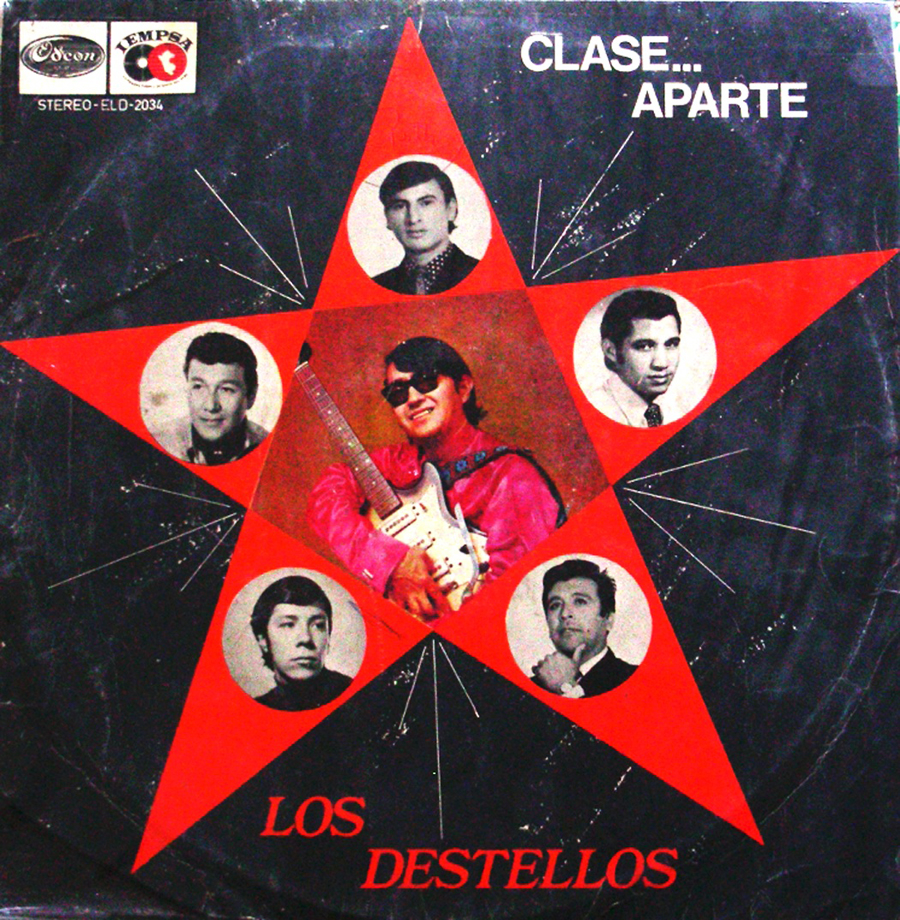Los Destellos (de Enrique Delgado)
In 1968 Peruvian Cumbia took a new turn. The driving force behind this turn was Enrique Delgado who formed Los Destellos in 1966, he was 27 years old. The reason: he dared to play cumbia with an electric guitar. He did it in 1968 on a 45 (‘El avispon’ / ‘La malvada’) featured later that year on the first LP of the band called ‘Los Destellos’ with Fernando Quiroz, Humberto “Tito” Caycho and Carlos Ramírez. The LP was released on the Odeon-Iempsa label.
httpvh://www.youtube.com/watch?v=ptREQKx5qqQ
La malvada’ from Los Destellos first album
Enrique Delgado’s new impulse came in a time of long hair, psychedelic colours, hallucinogenic drugs and pacifism. At the same time in Brazil, the great Caetano Veloso was letting his hair grow long and wild too.
Enrique Delgado had previously been playing the lead guitar in Creole music groups (Los Embajadorcitos, Los Palomillas). The Peruvian coastal Creole Waltz [Vals criollo] has been pointed out as one of the great influences of the Peruvian cumbia with its rhythmic electric guitars played with upstrokes. He also played with huayno performers (Pastorita Huaracina). The traditional highland huayano music is a genre of popular Andean music especially popular in Peru, characterized by high-pitched vocals accompanied by a variety of instruments, including guitar and harp, from which the Peruvian cumbia performers derive their electric guitar lines playing simultaneous melodie
From this melting pot of styles and rhythms, popular in the slums among lower classes, the music of Los Destellos constitutes an amazing musical fusion and amalgam of the time. As the Brazilian poet Oswald de Andrade earlier noted as Brazil greatest strength, and this holds not only for Brazil but for the entire latin America, Los Destellos went ‘cannibalizing’ acoustic traditions and modern technologies, which made possible the metamorphosis of cumbia into a heterodox genre of syncopated electric and frenetic sounds.
Los Destellos and Enrique Delgado’s musical ‘cannibalism’ exemplary appears in their merging of Cuban music and psychedelia, such as in their famous ‘Guajira sicodélica’, released in 1969.

Or in ‘Onstá la yerbita’, from the LP ‘Constelación’ (1971), a melody of abusing fuzz tones and distortion pedals (much of the like of Carlos Santana) with the plain hippie hemp apology; all elements that appear again in their remaking of cumbia in a sort of surf soul cliché as in ‘Volando alto’ from the album ‘Destellantes’ (1974).
httpvh://www.youtube.com/watch?v=PsxhkEBhM-M
httpvh://www.youtube.com/watch?v=hIKWZy5hsYY
The musical fusion of Los Destellos may not have the rhythmical muscle of Colombian cumbia driven by the almost hypnotic beat of the guacharaca and the tambora from the Amerindian and African heritage. The strength of Los Destellos lies, however, in their melodic emphasis put on the electric guitar that goes back to the quena and harp of the Andean tradition.
httpvh://www.youtube.com/watch?v=_hR7QhdQQOU





Social